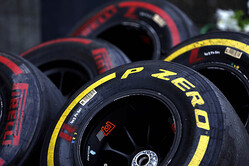


24/03/2014
NEWS STORY
 The new world of Formula One, with its new tyres, faces its toughest test yet in Malaysia: a circuit well-known for abrasive asphalt and extreme weather, which ranges from intense heat to monsoon-like downpours. To cope with these demanding conditions, the two hardest tyres in the range have been nominated: P Zero Orange hard and P Zero White medium. The evolutions brought to Pirelli's tyres this year increase strength and reduce degradation, but maintain the same sporting characteristics and performance, to enhance the racing spectacle.
The new world of Formula One, with its new tyres, faces its toughest test yet in Malaysia: a circuit well-known for abrasive asphalt and extreme weather, which ranges from intense heat to monsoon-like downpours. To cope with these demanding conditions, the two hardest tyres in the range have been nominated: P Zero Orange hard and P Zero White medium. The evolutions brought to Pirelli's tyres this year increase strength and reduce degradation, but maintain the same sporting characteristics and performance, to enhance the racing spectacle.
Paul Hembery: "Malaysia will obviously be only the second race that this completely new range of tyres, designed for the latest-generation Formula One cars, have ever competed in, and it also marks the debut of our 2014 hard tyre. The medium performed well in Melbourne, but Malaysia obviously presents a big contrast to Australia. We go from the smooth asphalt in Melbourne to a highly abrasive surface, and from the relatively cool conditions of Albert Park to much higher ambient and track temperatures. This of course will be as much of a challenge for the new cars as it is for the drivers, and we mustn't forget that we are still at a very early point in the overall learning curve. Wet conditions in qualifying in Australia allowed the teams to sample the 2014 intermediate and full wet tyres, and this knowledge could become very useful in Sepang."
Jean Alesi, Pirelli consultant driver: "Malaysia is one of the toughest races of the year, both for the driver and the tyres. But many of the corners flow quite well, so if you keep a good rhythm you can limit the stress on them. The biggest enemy of tyres in Malaysia is thermal degradation. It's going to take a few races yet before we see every team's full potential, which is an interesting situation. The other thing I always associate with Malaysia is heavy rain. The way that rain tyres have evolved since I was driving is incredible: I don't think anyone would have foreseen the rate of water dispersal that we can achieve now. The real problem in Sepang can be standing water: it's not tyres that are the limiting factor, but the fact that when you have huge quantities of water, the car 'surfs' along its flat bottom, which means you have no control at all. Visibility is also very difficult for the drivers following behind."
The circuit from a tyre point of view
Sepang is a fast circuit, with an average speed of over 210kph in qualifying and several flat-out corners. These high-speed accelerations make traction particularly crucial.
With the high-downforce set-up favoured by most teams, the tyres have to cope with not only high lateral loads, but also the equivalent of 830 kilograms pushing down on them. This challenging combination of forces leads to mechanical and thermal degradation.
The P Zero Orange hard tyre is a high working range compound, suitable for the most extreme conditions, whereas the P Zero White medium is a low working range compound. By adjusting the compound mix, the working ranges of all the tyres have been widened this year.
The same is true for the wet weather tyres. The rear tread pattern has been redesigned to improve resistance to aquaplaning in extremely wet weather, while the compound of the full wet tyre has been adjusted to allow it to cover a wider range of conditions. This year's full wet can evacuate 65 litres of water per second at 300kph: up by five litres from last year.
The front-left tyre is worked hardest in Malaysia: tyre temperature on the tread can peak at 120 degrees centigrade. In terms of friction energy, Sepang places the fourth-highest demand on the front-left tyre all year (after Silverstone, Barcelona and Suzuka).
Rain affected strategy last year, with the top five drivers all stopping four times. Judging the crossover points proved crucial. Sebastian Vettel (Red Bull) won: starting on intermediates before moving onto the medium tyre, then completing two stints on the hard tyre, before finishing on the medium.